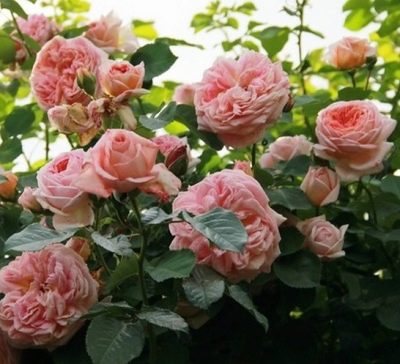
- Name synonyms: Alchymist
- Group: climbing
- The main color of the flower: orange
- Flower shape: at the beginning they are cupped, then the petals are bent down, and the flower becomes rosette-shaped, often lodged
- Flower size: large
- Diameter, cm: 10-12
- Flower type by number of petals: thick double
- Scent: fruity
- Description of the bush: medium vigor
- Bush height, cm: up to 350
The spectacular and bright climbing rose Alchemist belongs to the old German varieties that have been proving their excellent characteristics for many years. It is well adapted to the Russian climate, it has abundant flowering, and is not too capricious in its care. In Europe, the Alchemist variety is also found under the name Alchemist, Alchymiste, Alchimiste or Alchemist.
Breeding history of the variety
The rose was bred in the Kordes nursery in Germany in 1956. The parent plants were Golden Glow (Claymber, Brownell, 1937) x hybrid Rosa eglanteria L. synonim.
Description of the variety
The bushes of this rose variety show an average vigor. The length of the shoots reaches 3.5 m. The total width of the spreading bush can be up to 250 cm. On the shoots there are thorns and leaves of bright green color, shiny, dense. The lashes themselves are tough, very quickly increase in length, covering large areas.
The flowers of the Alchemist rose are large, 10-12 cm in diameter, densely double, with 55-60 petals in each, strong fruity aroma. Their main color is orange. Shades of petals vary in color from deep yellow to peach and creamy. They fade unevenly, so the corollas often look variegated, two-colored. Buds are formed in inflorescences, 3-7 pieces per stem.
The shape of the flower is cupped at the beginning, as the petals open, the edges are bent down. Fully open corolla rosette-shaped, sometimes lodged. The formation of buds occurs on the shoots of the last year.
Advantages and disadvantages
The alchemist is a rose variety that has many obvious virtues. The climbing bush looks great, exudes a wonderful aroma. Among its advantages are also:
- insensitivity to soil fertility;
- high resistance to heat;
- very good rain tolerance;
- frost resistance;
- long preservation of flowers on the branches.
The disadvantages of the variety include burning out of the petals in too bright sun. Also, the bushes require the mandatory use of support. The petals are colored unevenly, in coolness and partial shade they become more pink.
Flowering features
Rose Alchemist belongs to the once-flowering varieties. It blooms profusely throughout the summer. It has a very long flowering period.
Use in landscape design
This old European variety of roses belongs to the climbing category, so it is most often placed near supports, near gazebos or other objects. Shoots during the flowering period look good when cut. On the site they are placed singly or in groups. When a bush is formed around the column, the shoots are twisted from 1 year, otherwise they then become stiff, become too brittle and fragile.
Growing regions
The Alchemist variety is best adapted for growing in temperate climatic zones.
Landing
The Alchemist rose can be grown in partial shade, but it is better to set aside a plot for it on the south side, with acidified soil that allows water and air to pass through well.
Growing and care
Plants respond well to regular maintenance.It should be systematic, with the implementation of preventive treatments for ticks and leafhoppers, with spraying on the leaf in extreme heat. It is important to keep the soil in the root area in a loose state; the use of non-woven agricultural cloth or natural mulch will help reduce the growth of weeds.
Watering and feeding
In normal weather, without intense heat and prolonged rains, it is enough to irrigate roses of this variety 2 times a week. Water consumption rates for an adult bush are about 15 liters. In the heat, watering is carried out every other day or daily. The best fertilizers for this variety are special, liquid, with mineral complexes corresponding to the growing season.
Pruning
Bushes require mandatory sanitary pruning in spring and autumn.
Diseases and pests
This variety of roses requires careful protection from diseases and pests. Plants are affected by black spot, but are resistant to powdery mildew.
Review overview
Amateur gardeners often acquire the Alchemist rose as yellow, but as the shoots grow, they get a plant with peach-pink, salmon petals. However, everything is redeemed by a very beautiful, lush cup shape, pronounced terry and excellent aroma. The average duration of the budding period for this rose is about 4 weeks, so it is rarely used in single plantings. Summer residents are advised to surround the bush with honeysuckle, morning glory or wisteria in order to preserve the decorative effect of the flower garden.
Many mentions in reviews are related to the length of the lashes. Sometimes it reaches 6 m, and after lignification, the lashes acquire fragility, which complicates the creation of a shelter for the winter. The many stiff thorns on the stems are considered a noticeable disadvantage. Cutting or tying to a support can cause injury and damage to the skin.































































